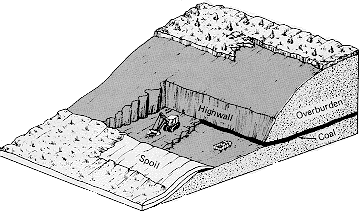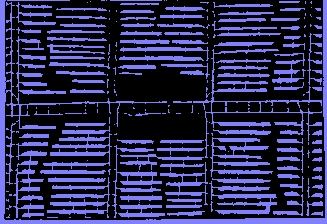Coal and Gas Hydrate Resources
Coal and Gas Hydrate Resources
go back to Contents of Entire Course...
Coal
Disadvantages of Coal
Mining Coal
Underground mining
Gas Hydrates
Links
adapted to HTML from lecture notes of Prof. Stephen A. Nelson Tulane University
Coal
- Provides 25% of world energy
- The world has 1 trillion tons of reserve
- U.S. has about 300 billion tons
- If all energy was to be supplied by coal, U.S. would have enough for at least 200 years
- Australia also has hundreds of years of resrerves
- Dominantly from plants buried in swamp environment
- On burial the coal changes character in the following stages:
- peat
- lignite
- bituminous - The coal most of us are used to seeing. Black, "dirty" coal.
- anthracite - Hard, shiny black rock. Does not easily rub off onto your fingers.
- The steps in the transformation from buried plant debris to coal.
Formation of Coal
- Sulfur as sulfide oxides to form sulfuric acid in mines or on burning causes acid rain.
- Strip mining while cheapest, needs reclamation.
- Underground mining- subsidence.
- Ash left is 5- 20% of original volume.
- Transporting coal is difficult.
- Trains - Primary method of transportation.
- Conversion to electricity on site - The problem with this method is that you then need to transfer the power to remote locations that can use it. Transporting electricity loses a great deal of energy.
- Coal slurry in pipelines - Mixing coal with water to produce a semi-liquid material that can be piped. This is not done very much.
- Conversion to synthetic oil or gas - used to be done quite often to produce gas, before actual natural gas sources were utilized. One problem with this method is that the natural gas produced by this method happens to contain quite a lot of carbon monoxide mixed in with the methane.
Disadvantages of Coal
Mining Coal
- As the name implies, this form of mining simply takes coal from near
the surface. First, the vegetation and soil overlying the coal must be
removed. Then any rocks or overburden must be removed, generally by
blasting with explosives and by using heavy land moving equipment.
This waste rock is then set aside in spoil piles while the coal
underneath is mined, and is replaced after the mining process is
completed. This method of mining generally recovers almost 100% of the
coal present in the deposit.
- There are two major forms of mines that are created using this
method of mining. The first is a strip mine:

The other form of surface mining is that of a contour mine used in mountainous areas:

Surface spoils from haphazard coal mining pose severe acid drainage and contamination problems.
Underground mining
Another method employed to mine for coal is to dig underground, removing coal, in the more traditional image of mining. This method creates tunnels and caverns. These can either be dug into the side of a mountain where a known coal deposit outcrops, or into more flat topography, digging straight down. A map view of this style of mine looks like the following:
Dark areas are coal that is left behind to hold the overlying rock.
Lighter areas are mined.
- This method of mining recovers only fraction of the available coal.
- Sinkholes and troughs can be caused by this form of coal mining after the mines have been abandoned and the overburden collapses into the tunnels..

Links of Interest
For those of you who are further interested in the subjects covered in this lecture, the following are links to other web sites covering these subjects.
- The Department of Energy's news page about fossil fuels. This web page covers current headlines and activities regarding fossil fuels and associated power sources.
- The U.S.G.S. provides a good page on fossil energy resources. They cover coal, oil, gas, and their usages, availability, and environmental impacts.

